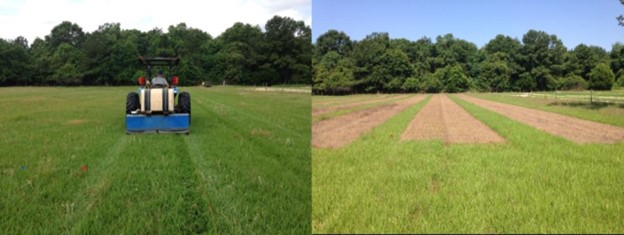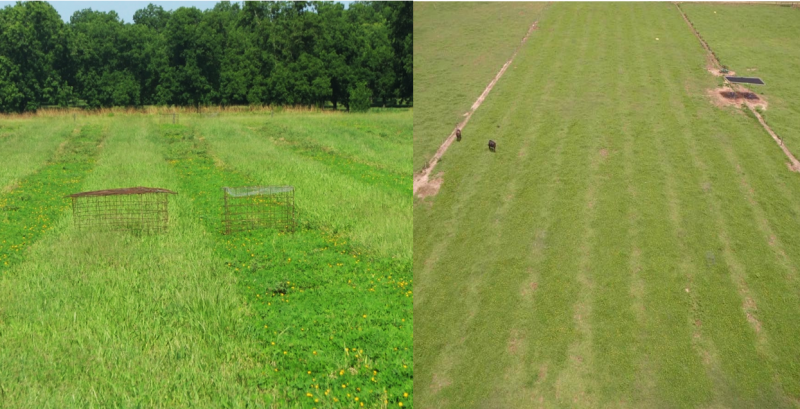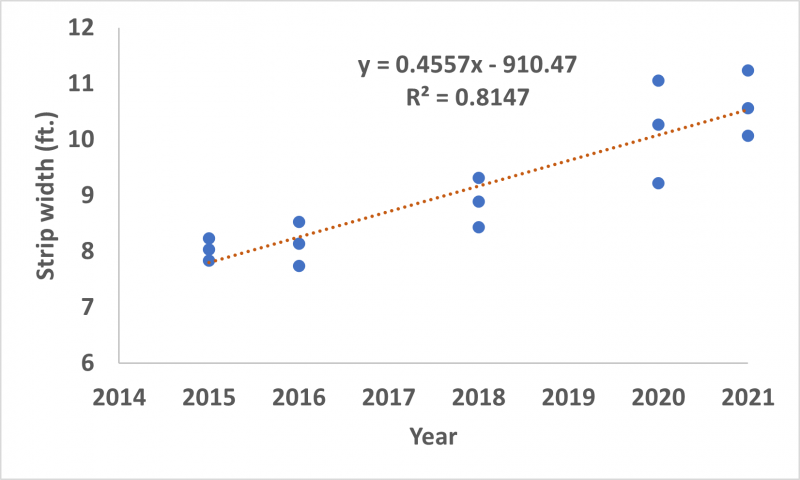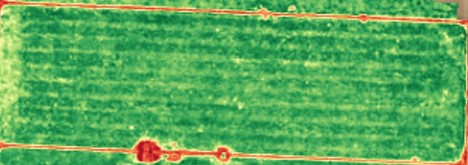Jose Dubeux, L. Garcia, D. Jaramillo, J. Pereira Neto, K. Trumpp, L. Queiroz, E. Santos, I. Brêtas, M. Bernardini, J. Portuguez, K. Oduor, M. Ruiz-Moreno, UF/IFAS North Florida Research and Education Center
Introduction
Rhizoma perennial peanut (RP) is a warm-season perennial legume that is well adapted to Florida’s environmental conditions. This legume species is also grazing tolerant. In fact, we have fields in Florida under grazing for more than 40 years that are still productive. Rhizoma peanut has great nutritive value, with 15-18% crude protein concentration and 65-70% digestibility. Integrating RP into bahiagrass has resulted in increased average daily gain of yearling steers by 70-80% during the summer (Jaramillo et al., 2021). Rhizoma peanut also fixes nitrogen from the air by associating with soil bacteria, reducing the need to add industrial nitrogen (N) fertilizer. In fact, in pure stand RP can fix large amounts of N (Dubeux et al., 2017). When mixed in bahiagrass pastures, the amount of biological nitrogen fixation will depend on the proportion of the RP in the sward.
Establishing RP takes time and greater expense than seeded forages. One approach to reduce the cost is to strip-plant RP into existing bahiagrass pastures (Dubeux et al. 2022). Strips can cover 50% of the area, therefore, establishment costs are greatly reduced. During the establishment period (1-2 yrs.), cattle should not be allowed to graze the pasture. They select RP over bahiagrass and would likely overgraze the RP strips. However, grass strips could be used for hay. Strip width should match planting and spraying equipment. Because the RP is in a solid stand in the strip during the establishment, there are better weed management options compared to mixed with grasses at establishment time. At UF/IFAS NFREC Marianna, our strips at planting were 8-ft. wide (Figure 1). With time, RP will spread laterally and mix with the bahiagrass. The long-term goal is to have a mixed sward of bahiagrass and RP.

Figure 1. Strips of Ecoturf Rhizoma Peanut in Argentine bahiagrass pastures at UF IFAS NFREC Marianna. Photo credit: Jose Dubeux, UF/IFAS
–
Establishing the strips
Typically, RP is planted either in the spring or summer. It is important to avoid dry weather, so, summer might be safer after the onset of summer rainfall. If you plan to strip-plant onto pre-existing bahiagrass pasture, you will need to kill the bahiagrass along the strip with glyphosate (Figure 2). After killing the pre-existing vegetation, the strips should be prepared before planting. Weed management during the establishment year is important. Imazapic is an option as pre-emergent or early postemergence herbicide at the recommended rate of 4 oz./acre. If grass weeds are a problem, clethodim products can be used following label recommendations. Rhizoma peanut should be planted at 80 bushels of rhizomes per acre. This rate should be applied to the strip area, but because the strips only cover 50% of the entire area, less planting material is used to plant one acre of mixed bahiagrass-RP pastures. Ecoturf has been used in grazing systems and is an ideal choice because of its grazing tolerance.(Jaramillo et al., 2021).

Figure 2. Glyphosate application to prepare strips prior to planting rhizoma perennial peanut. Photo credit: Jose Dubeux, UF/IFAS
–
How Well Did it Work Long-Term?
At UF IFAS NFREC Marianna, we established strips of RP into Argentine bahiagrass pastures in June 2014. These pastures have been managed over the years with summer grazing and overseeded with cool-season forages every year since then (Figure 3).

Figure 3. On the left, strips of RP in 2015, one year after establishment. On the right, strips of RP in 2021, 7 years after establishment. Photo credit: Jose Dubeux, UF/IFAS
–
Since the establishment of the strips, we have been measuring the strip width through the years. It is interesting to note that the RP spread laterally over the years, as indicated in Figure 4. In fact, the RP strips are now mixed with bahiagrass, but in a darker green color compared with places where only the bahiagrass is present. In a multispectral image taken with a drone recently we can clearly distinguish the dark and light green colors in the pastures where the RP strips are present (Figure 5).

Figure 4. Width of rhizoma peanut strips under grazing conditions along the years at UF IFAS NFREC Marianna.
–

Figure 5. Multispectral image taken with a drone indicating the dark and light green colors of the RP strips on a mixed RP-bahiagrass pasture at UF IFAS NFREC Marianna.
–
Take Home Message
Strip-planting rhizoma perennial peanut into bahiagrass pastures is a viable option. It reduces the cost of establishment and with time, the rhizoma peanut will spread laterally and mix with the bahiagrass. There are cost-share options available to reduce the costs even more. Integrating rhizoma peanut into bahiagrass pastures increases animal performance by 70-80% during the summer, meeting the target of developing heifers. Savings on nitrogen (N) fertilizer and reduction of nitrate leaching is another important aspect of this mixture that must also be considered.
–
References
Dubeux, J.C.B., Jr., A.R.S. Blount, C. Mackowiak, E.R.S. Santos, J.D. Pereira Neto, U. Riveros, L. Garcia, D.M. Jaramillo, M. Ruiz-Moreno. 2017. Biological N2 fixation, belowground responses, and forage potential of rhizoma peanut cultivars. Crop Science 57:1027-1038.
Dubeux, J.C.B., Jr., L. Sollenberger, J. Vendramini, M. Wallau, A. Blount, L. Garcia-Jimenez, E. Santos, D. Jaramillo. 2022. Strip-planting rhizoma peanut into grazing systems. University of Florida IFAS, EDIS SS-AGR-421
Jaramillo, D., J.C.B. Dubeux, Jr., L.E. Sollenberger, J.M.B. Vendramini, C. Mackowiak, N. DiLorenzo, L. Garcia, L.M.D. Queiroz, E.R.S. Santos, B.G.C. Homem, F. van Cleef, M. Ruiz-Moreno. 2023. Water footprint, herbage, and livestock responses for nitrogen-fertilized grass and grass-legume grazing systems. Crop Science 2021; 61:3844-3858.
- Grazing Cover Crops is a Triple Win! - August 15, 2025
- How are My Cool-season Forages Recovering from the Snowfall and Low Temperatures? - January 31, 2025
- Integrated Crop-Livestock Systems Improve Soil Health - July 26, 2024
